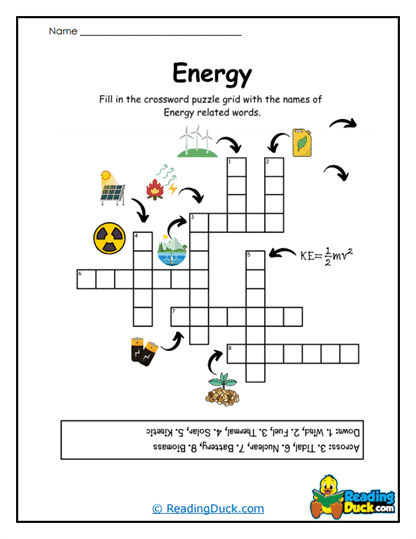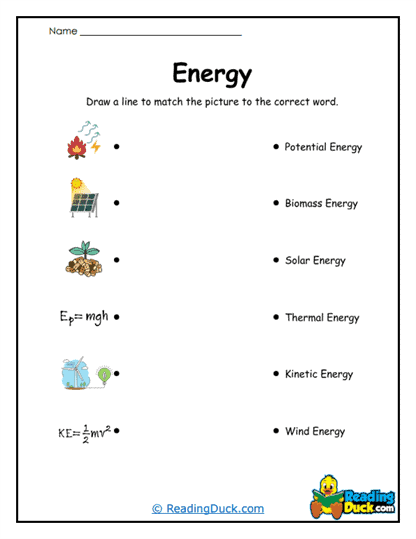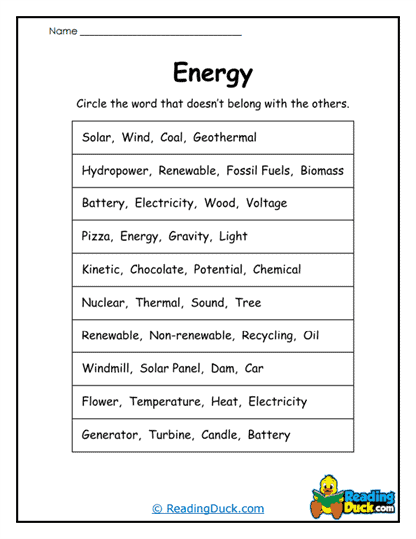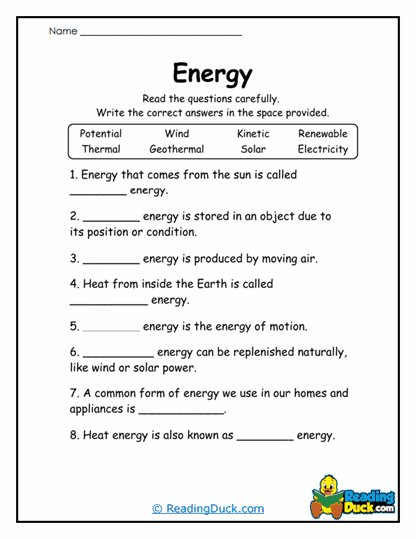Energy Words Worksheets
About Our Energy Vocabulary Words Worksheets
Energy is a fundamental concept in science that underpins numerous topics in physics, chemistry, and even biology. However, the terminology related to energy can often be complex and overwhelming for students. Energy Vocabulary Words Worksheets serve as a valuable educational resource designed to help students master the language of energy, ensuring they have a strong foundation for deeper scientific understanding. These worksheets typically focus on key energy-related terms, such as “kinetic energy,” “potential energy,” “thermal energy,” and “conservation of energy,” and they present opportunities to reinforce these terms through exercises that cater to a variety of learning styles.
For teachers and homeschoolers, these worksheets offer structured, engaging ways to introduce and review critical vocabulary. By breaking down complex terms into manageable definitions, examples, and practice activities, worksheets allow educators to scaffold student learning effectively. Worksheets might include matching activities, fill-in-the-blank exercises, crossword puzzles, and labeling diagrams, ensuring that students not only recognize terms but can apply them in different contexts. This process enhances comprehension and retention while enabling educators to assess students' grasp of the material easily.
They can be used as pre-teaching activities to introduce unfamiliar concepts before a lesson, as reinforcement exercises during instruction, or as review tools to assess understanding at the end of a unit. For homeschoolers, these worksheets are especially useful because they provide structured guidance for teaching science topics without needing specialized materials or extensive background knowledge. Many worksheets are designed to align with science curricula, ensuring that they meet grade-level standards.
These worksheets are not just about rote memorization. Effective energy vocabulary worksheets encourage students to engage with terms in meaningful ways. For instance, a worksheet might require students to identify real-world examples of kinetic or potential energy, write short explanations of energy transformations, or draw illustrations of terms like “solar energy” or “sound energy.” By connecting vocabulary to everyday phenomena, students gain a more practical and tangible understanding of energy concepts, which helps to deepen their learning and spark curiosity.
The flexibility of energy vocabulary worksheets also makes them ideal for differentiated instruction. Teachers can choose worksheets of varying difficulty levels or modify activities to meet individual student needs. Visual learners might benefit from diagram-based worksheets, while verbal learners may prefer matching exercises or written definitions. For kinesthetic learners, hands-on activities like building energy transformation models can accompany these worksheets to enhance comprehension. This adaptability ensures that every student has the opportunity to engage with the material in a way that best suits their learning style.
They provide a clear, organized method for introducing, reinforcing, and assessing energy-related terminology, making complex scientific concepts accessible to students of all levels. By incorporating engaging activities and real-world examples, these worksheets help students connect vocabulary to their daily lives, foster deeper understanding, and build confidence in science. Whether used as part of a structured science curriculum or as supplementary learning materials, they empower educators to teach energy concepts effectively while keeping students actively involved in the learning process.
Energy Vocabulary Words That We Explore
Kinetic Energy - Kinetic energy is the energy of motion. Any object that is moving, such as a rolling ball or a moving car, possesses kinetic energy. The amount of kinetic energy depends on the object's mass and velocity, meaning heavier and faster objects have more kinetic energy.
Potential Energy - Potential energy is stored energy that an object has because of its position or condition. For example, a book on a high shelf or a stretched rubber band has potential energy due to gravity or elasticity. When the object moves or changes position, this stored energy can be released.
Thermal Energy - Thermal energy refers to the internal energy within a substance due to the motion of its molecules. It is often experienced as heat and increases as the temperature rises. This energy can transfer between objects through conduction, convection, or radiation.
Mechanical Energy - Mechanical energy is the total energy an object possesses due to its motion (kinetic energy) and position (potential energy). For example, a swinging pendulum has both kinetic and potential energy, combining to form mechanical energy. It is crucial in systems like machines, vehicles, and engines.
Chemical Energy - Chemical energy is the energy stored in the bonds of chemical compounds, such as in food, fuel, and batteries. When these bonds are broken during a chemical reaction, the stored energy is released. This energy powers processes like digestion, combustion, and electrical devices.
Electrical Energy - Electrical energy is the energy caused by the movement of electric charges, often delivered through circuits. It powers devices like lights, computers, and appliances. Electricity can be generated from sources like fossil fuels, solar panels, or wind turbines.
Nuclear Energy - Nuclear energy is released during nuclear reactions, either through fission (splitting atoms) or fusion (combining atoms). This energy is used to generate electricity in nuclear power plants and is also responsible for the sun’s immense energy output. While highly efficient, it requires careful handling due to its radioactive byproducts.
Radiant Energy - Radiant energy is energy that travels in the form of electromagnetic waves, such as light, radio waves, or X-rays. The sun is a primary source of radiant energy, which provides light and warmth to Earth. It is essential for processes like photosynthesis and solar power generation.
Gravitational Energy - Gravitational energy is the potential energy an object has due to its height above the ground. The higher an object is lifted, the more gravitational energy it stores. When the object falls, this energy converts into kinetic energy.
Sound Energy - Sound energy is produced when an object vibrates, causing waves to travel through a medium, like air or water. Our ears detect these vibrations as sound. Examples include voices, music, and the noise from a vibrating tuning fork.
Solar Energy - Solar energy is energy harnessed from the sun’s radiant light and heat. It is captured using technologies like solar panels, which convert it into electricity or thermal energy. Solar energy is renewable and plays a key role in sustainable energy solutions.
Elastic Energy - Elastic energy is the potential energy stored in an object when it is stretched, compressed, or deformed, such as in a rubber band or a spring. When the object returns to its original shape, the stored energy is released. This energy is used in devices like trampolines or mechanical toys.
Conservation of Energy - The law of conservation of energy states that energy cannot be created or destroyed, only transferred or transformed. In a closed system, the total energy remains constant, though it can change forms. For example, a roller coaster converts potential energy into kinetic energy and vice versa.
Heat Energy - Heat energy, a form of thermal energy, is transferred from warmer objects to cooler ones. This transfer occurs through conduction, convection, or radiation. Heat energy is vital for processes like cooking food, boiling water, and heating homes.
Energy Transformation - Energy transformation is the process of energy changing from one form to another. For instance, a toaster transforms electrical energy into thermal energy to toast bread. Understanding these transformations is crucial for designing efficient energy systems.









